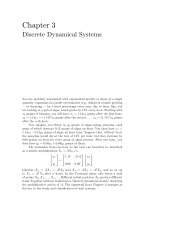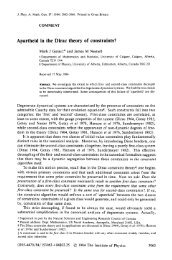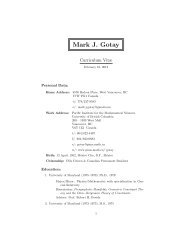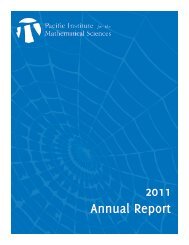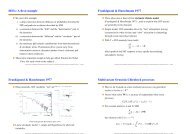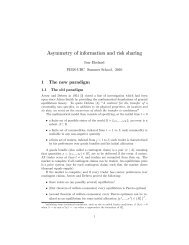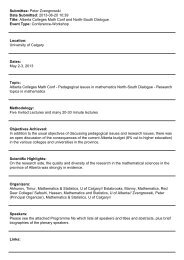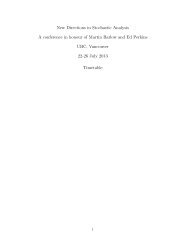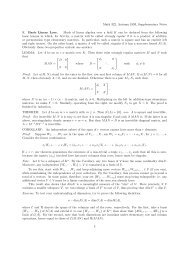11 PRIMA 2013 AbstractsEnumer<strong>at</strong>ing, counting, and determining the maximumnumber of various objects in graphs have long been establishedas important areas within graph theory and graphalgorithms. As the number of enumer<strong>at</strong>ed objects is veryoften exponential in the size of the input graph, enumer<strong>at</strong>ionalgorithms fall into two c<strong>at</strong>egories depending on theirrunning time: those whose running time is measured inthe size of the input, and those whose running time ismeasured in the size of the output. Based on this, weconcentr<strong>at</strong>e on the following two types of algorithms.1. Exact exponential time algorithms. The design ofthese algorithms is mainly based on recursive branching.The running time is a function of the size of the inputgraph, and very often it also gives an upper bound on thenumber of enumer<strong>at</strong>ed objects any graph can have.2. Output polynomial algorithms. The running time ofthese algorithms is polynomial in the number of the enumer<strong>at</strong>edobjects th<strong>at</strong> the input graph actually contains.Some of these algorithms have even better running timesin form of incremental polynomial or polynomial delay,depending on the time the algorithm spends between eachconsecutive object th<strong>at</strong> is output.The methods for designing the two types of algorithmsare usually quite different. Common to both approachesis th<strong>at</strong> efforts have traditionally mainly been concentr<strong>at</strong>edon arbitray graphs, whereas graphs with particular structurehave largely been left un<strong>at</strong>tended. In this talk welook <strong>at</strong> enumer<strong>at</strong>ion of objects in graphs with specialstructure. In particular, we focus on enumer<strong>at</strong>ing minimaldomin<strong>at</strong>ing sets in various graph classes.Algorithms of type 1: The number of minimal domin<strong>at</strong>ingsets th<strong>at</strong> any graph on n vertices can have is knownto be <strong>at</strong> most 1.7159 n . This upper bound might not betight, since no examples of graphs with 1.5705 n or moreminimal domin<strong>at</strong>ing sets are known. For several classesof graphs, like chordal, split, and proper interval graphs,we substantially improve the upper bound on the numberof minimal domin<strong>at</strong>ing sets. At the same time, wegive algorithms for enumer<strong>at</strong>ing all minimal domin<strong>at</strong>ingsets, where the running time of each algorithm is withina polynomial factor of the proved upper bound for thegraph class in question. In some cases, we provide examplesof graphs containing the maximum possible numberof minimal domin<strong>at</strong>ing sets for graphs in th<strong>at</strong> class,thereby showing the corresponding upper bounds to betight.Algorithms of type 2: Enumer<strong>at</strong>ion of minimal domin<strong>at</strong>ingsets in graphs has very recently been shown to beequivalent to enumer<strong>at</strong>ion of minimal transversals in hypergraphs.The question whether the minimal transversalsof a hypergraph can be enumer<strong>at</strong>ed in output polynomialtime is a fundamental and challenging question;it has been open for several decades and has triggeredextensive research. We show th<strong>at</strong> all minimal domin<strong>at</strong>ingsets of a line graph can be gener<strong>at</strong>ed in incrementalpolynomial, and consequently output polynomial, time.We are able to improve the delay further on line graphsof bipartite graphs. Finally we show th<strong>at</strong> our methodis also efficient on graphs of large girth, resulting in anincremental polynomial time algorithm to enumer<strong>at</strong>e theminimal domin<strong>at</strong>ing sets of graphs of girth <strong>at</strong> least 7.The present<strong>at</strong>ion is based on joint works with followingco-authors: Jean-Francois Couturier, Petr Golovach, Pimvan ’t Hof, Dieter Kr<strong>at</strong>sch, and Yngve Villanger.M<strong>at</strong>rix partitionsPavol HellSimon Fraser University, Canadapavol@sfu.caI will survey recent work on vertex partitions of graphswith certain internal and certain external constraints.(These constraints are conveniently encoded in a m<strong>at</strong>rix.)Many well studied examples, especially from the study ofperfect graphs, fit into this model. The results discussedwill include both algorithms and characteriz<strong>at</strong>ions. Manyopen problem will be posed.The lexicographic methodJing HuangUniversity of Victoria, Canadajing@m<strong>at</strong>h.uvic.caLexicographic techniques have been identified as an importanttool in the design of graph algorithms. In thistalk I will give a short survey of how the techniques areused for solving graph problems such as recognitions, orient<strong>at</strong>ions,represent<strong>at</strong>ions, and homomorphisms.On m-walk-regular graphs, a generaliz<strong>at</strong>ion ofdistance-regular graphsJack KoolenUniversity of Science and Technology of China, China andPohang University of Science and Technology, Koreakoolen@postech.ac.krIn this talk I will discuss m-walk-regular graphs. Thesegraphs were introduced by Fiol and Garriga in 1999 as ageneraliz<strong>at</strong>ion of distance-regular graphs. 0-Walk-regulargraphs were earlier introduced by Godsil and McKay aswalk-regular graphs. They showed th<strong>at</strong> a graph G is walkregularif and only if the spectrum of G where I delete avertex x does not depend on the vertex x.Our main motiv<strong>at</strong>ion to study m-walk-regular graphs is tounderstand the difference between m-walk-regular graphsand distance-regular graphs. We will show th<strong>at</strong> manyresults on distance-regular graphs can be generalized to2-walk-regular graphs. We also give many examples of m-walk-regular graphs which are not distance-regular. Butwe also show th<strong>at</strong> some results on distance-regular graphsare not true for 2-walk-regular graphs.Geometric represent<strong>at</strong>ions of graphsJan Kr<strong>at</strong>ochvilCharles University in Prague, Czech Republichonza@kam.mff.cuni.czGeometric represent<strong>at</strong>ions of graphs are intensively studiedboth for their practical motiv<strong>at</strong>ion and interestingcombin<strong>at</strong>orial properties. We will survey recent developmentin this area, including recent results on coloring geometricintersection graphs and comput<strong>at</strong>ional complexityof extending partial geometric represent<strong>at</strong>ions.The practice of graph isomorphismBrendan D. McKayAustralian N<strong>at</strong>ional University, Australiabdm@cs.anu.edu.auWe are concerned with the practical aspects of computingthe automorphism groups of graphs, and determiningcanonical labellings of graphs. The speaker’s programnauty has been around since 1976, though it wasn’t calledth<strong>at</strong> until about 1983. Until a few years ago, there wasn’tvery much competition, but then came saucy, Bliss,conauto, and some other programs th<strong>at</strong> could outperformnauty in many cases.Our aim in the talk is to describe our response to thechallenge. In particular, nauty is now bundled with ahighly innov<strong>at</strong>ive program called Traces. We contendth<strong>at</strong> the present edition of Traces is now the performancechampion. The talk will describe how these programswork and give a comparison between them.This is joint work with Adolfo Piperno (University ofRome).
12 PRIMA 2013 AbstractsStructural limits in logical and analytic contextJaroslav NešetřilCharles University in Prague, Czech Republicnesetril@iuuk.mff.cuni.czWe survey recent development of limits of graphs (andother structures) in the unifying context of model theory.Particularly, this leads to the analysis of limits of sparsegraphs (with unbounded degrees). This is joint work withP<strong>at</strong>rice Ossona de Mendez (EHESS, Paris).Unavoidable vertex-minors in large primegraphsSang-il OumKorea Advanced Institute of Science and Technology, Koreasangil@kaist.eduA graph is prime (with respect to the split decomposition)if its vertex set does not admit a partition (A, B)(called a split) with |A|, |B| ≥ 2 such th<strong>at</strong> if a pair of verticesin A have neighbors in B, then they have the sameset of neighbors in B. We prove th<strong>at</strong> for each t, every sufficientlylarge prime graph must contain a vertex-minorisomorphic to either a cycle of length t or a graph consistingof two vertices joined by t 3-edge p<strong>at</strong>hs and no otheredges. This is a joint work with O-joung Kwon (KAIST).The structure of a typical H-free graphBruce ReedMcGill University, Canadabreed@cs.mcgill.caWe discuss the structure of a typical graph which does notcontain H as an induced subgraph and prove a weakeningof the Erdos-Hajnal conjecture. The talk presents jointwork with F. Havet, R. Kang, P. Keevash, M. Loebl, C.McDiarmid, J. Noel, A. Scott, and A. Thomason.Hamiltonian cycles in prismsMoshe RosenfeldUniversity of Washington, Tacoma, USAmoishe@uw.eduThe prism over a graph G is the Cartesian product ofG with K 2 . My interest in prisms began in 1973 whenI tried to tackle Dave Barnette’s conjecture (1970) th<strong>at</strong>all simple 4-polytopes are Hamiltonian (still open). Subsequently,we merged the study of Hamiltonian cycles inprisms with other refinements of Hamiltonian cycles. Weobserved th<strong>at</strong> if G has a Hamiltonian prism then G hasa spanning closed 2-walk but the opposite is not true,th<strong>at</strong> is having a Hamiltonian prism is "closer" to beingHamiltonian than having a spanning, closed 2-walk. Thisobserv<strong>at</strong>ion cre<strong>at</strong>ed many opportunities to study variousclassical problems on Hamiltonicity of graphs.In this talk I will discuss some results on prism Hamiltonicity,further refinements of Hamiltonicity and rel<strong>at</strong>edopen problems.On the comput<strong>at</strong>ion of the Radon number insome graph convexitiesJayme L SzwarcfiterFederal University of Rio de Janeiro, Braziljayme@nce.ufrj.brA graph convexity is a pair (G, C), where G is a finitegraph with vertex V (G) and C a family of subsets ofV (G) s<strong>at</strong>isfying ∅, V (G) ∈ C and being closed under intersections.The sets C ∈ C are called convex sets. Themost common graph convexities are those whose convexsets are defined through special p<strong>at</strong>hs of the graph.Among them the most prominent are the geodesic convexity,where C is closed under taking shortest p<strong>at</strong>hs, themonophonic convexity, where C is closed under inducedsubgraphs and the P 3 convexity, whose convex sets areclosed under pairs of common neighbors. In special, thel<strong>at</strong>ter is closely rel<strong>at</strong>ed to some well studied graph processes,as percol<strong>at</strong>ion and conversion processes. We examinesome common parameters of graph convexities, as thegeodetic number, convexity number, hull number, Hellynumber, Car<strong>at</strong>héodory number and Radon number. Inparticular, we describe complexity results rel<strong>at</strong>ed to thecomput<strong>at</strong>ion of the Radon number. These include hardnessresults, polynomial-time algorithms and bounds.A class of periodic continued fractions andfactoriz<strong>at</strong>ion in modular groupMikhail TyaglovShanghai Jiao Tong University, Chin<strong>at</strong>yaglov@sjtu.edu.cnIn this talk we introduce some properties of periodiccontinued fractions of the form−1 −1 −1b 1 + b 2 +···+ b} {{ n}n+−1 −1 −1b 1 + b 2 +···+ b · · · , (1)} {{ n +}nwhere b k are (positive) integers. Such continued fractionsare called periodic neg<strong>at</strong>ive-regular continuedfraction. By Tietze’s theorem [1], the fraction (1)converges to an irr<strong>at</strong>ional number if |b k | 2 (exceptfor the case |b k | = 2 for all k).We have proved th<strong>at</strong> without the requirement |b k | 2 the fraction (1) may converge to r<strong>at</strong>ional numbersor diverge. This is the difference between neg<strong>at</strong>iveregularcontinued fractions and classical regular continuedfractions. The last one always converge toirr<strong>at</strong>ional numbers.Several algorithms for construction of periods{b 1, . . . , b n} of periodic neg<strong>at</strong>ive-regular continuedfractions converging to r<strong>at</strong>ional numbers are given.The periods of a given length can be obtained by Ferm<strong>at</strong>’sinfinite descent method applied to some Diophantineequ<strong>at</strong>ions. An explicit simple formula forthe minimal period for x is presented. A constructionusing the Calkin-Wilf tree and Stern’s di<strong>at</strong>omic seriesis described. Arbitrary primitive periods are in oneto-onecorrespondence with elements of the modulargroup Γ. Explicit formulas converting products ofthe standard gener<strong>at</strong>ors S and ST in Γ into primitiveperiods are obtained. The periods of elliptic elementsof Γ are completely described. This description resultsin a parametric formula for primitive periods ofr<strong>at</strong>ional numbers. A periodic neg<strong>at</strong>ive-regular continuedfraction diverges if and only if either its periodor its double or its triple represents the identity inΓ.[1] H. Tietze, "Uber Kriterien für Konvergenz undIrr<strong>at</strong>ionalität unendlicher Ketenbrüche”, M<strong>at</strong>h. Ann.70 (1911).The graph isomorphism problem on geometricgraphs
- Page 2 and 3:
1PRIMA 2013-Table of ContentsTable
- Page 4 and 5:
3PRIMA 2013-OrganizationOrganizatio
- Page 6 and 7:
5PRIMA 2013-OrganizationYoshikazu G
- Page 8 and 9: 7PRIMA 2013-Useful InformationUsefu
- Page 10 and 11: 9PRIMA 2013-Useful InformationTaxi:
- Page 12 and 13: 11PRIMA 2013-Useful Informationmath
- Page 14 and 15: 13PRIMA 2013 Program-Schedule-at-a-
- Page 16 and 17: 15PRIMA 2013 Program-Monday, June 2
- Page 18 and 19: 17PRIMA 2013 Program-Monday, June 2
- Page 20 and 21: 19PRIMA 2013 Program-Monday, June 2
- Page 22 and 23: 21PRIMA 2013 Program-Monday, June 2
- Page 24 and 25: 23PRIMA 2013 Program-Tuesday, June
- Page 26 and 27: 25PRIMA 2013 Program-Tuesday, June
- Page 29 and 30: 28PRIMA 2013 Program-Tuesday, June
- Page 31 and 32: 30PRIMA 2013 Program-Tuesday, June
- Page 33 and 34: 32PRIMA 2013 Program-Wednesday, Jun
- Page 35 and 36: 34PRIMA 2013 Program- Thursday, Jun
- Page 37 and 38: 36PRIMA 2013 Program- Thursday, Jun
- Page 39 and 40: 38PRIMA 2013 Program- Thursday, Jun
- Page 41 and 42: 40PRIMA 2013 Program- Thursday, Jun
- Page 43 and 44: 42PRIMA 2013 Program- Friday, June
- Page 45 and 46: 44PRIMA 2013 Program- Friday, June
- Page 48 and 49: 1 PRIMA 2013 AbstractsContents1 Pub
- Page 50 and 51: 3 PRIMA 2013 Abstractsof subfactors
- Page 52 and 53: 5 PRIMA 2013 AbstractsprocessesXu S
- Page 54 and 55: 7 PRIMA 2013 AbstractsIn this talk
- Page 56 and 57: 9 PRIMA 2013 Abstractsindependently
- Page 60 and 61: 13 PRIMA 2013 AbstractsRyuhei Uehar
- Page 62 and 63: 15 PRIMA 2013 AbstractsIn this talk
- Page 64 and 65: 17 PRIMA 2013 AbstractsSpecial Sess
- Page 66 and 67: 19 PRIMA 2013 Abstractscritical slo
- Page 68 and 69: 21 PRIMA 2013 AbstractsSpecial Sess
- Page 70 and 71: 23 PRIMA 2013 Abstractsstrictly awa
- Page 72 and 73: 25 PRIMA 2013 AbstractsPedram Hekma
- Page 74 and 75: 27 PRIMA 2013 Abstractsis well-know
- Page 76 and 77: 29 PRIMA 2013 Abstractssolid substr
- Page 78 and 79: 31 PRIMA 2013 AbstractsRapoport-Zin
- Page 80 and 81: 33 PRIMA 2013 Abstractssense. Our a
- Page 82 and 83: 35 PRIMA 2013 AbstractsIn an econom
- Page 84 and 85: 37 PRIMA 2013 AbstractsKyoto Univer
- Page 86 and 87: 39 PRIMA 2013 AbstractsAlexander Mo
- Page 88 and 89: 41 PRIMA 2013 AbstractsOsamu SaekiK
- Page 90 and 91: 43 PRIMA 2013 Abstractsopen Delzant
- Page 92 and 93: 45 PRIMA 2013 AbstractsJian ZhouTsi
- Page 94 and 95: 47 PRIMA 2013 AbstractsJiaqun WeiNa
- Page 96 and 97: 49 PRIMA 2013 Abstractsthe end of 2
- Page 98 and 99: 51 PRIMA 2013 AbstractsJongyook Par
- Page 100 and 101: 53 PRIMA 2013 AbstractsPancyclicity
- Page 102 and 103: 55 PRIMA 2013 AbstractsEfficient nu
- Page 104 and 105: 57 PRIMA 2013 Abstractsand fountain
- Page 106: 59 PRIMA 2013 Abstractsformula esti



